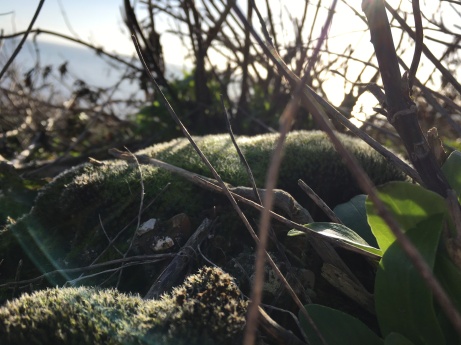Last Wednesday was sunny for a change, the wind had dropped and the sky was Yves Klein blue, the perfect day for a visit to the chalk cliffs. I decided to fill in the gap in my surveying and walk from Rottingdean to Saltdean along the top of the cliffs.
There were a few mosses around the edge of the car park above Rottingdean sea front, but nothing unusual, and this tetrad, TQ30R is quite well recorded. The grassy cliff tops looked as if they would be full of chalk grassland flowers in the summer and there was even a bit of Black Knapweed still in flower but the path was trampled coarse grass and there were very few bare patches for bryophytes to grow on. Just before descending into Saltdean, near a bus stop, there were some stony areas of more heavily walked earth with a few bryophytes. Most of the mosses here were the ubiquitous Tortula muralis and Barbula unguiculata but there were some scraps of Microbryum so I collected some samples for microscopic examination. A little bit further along a micro moss was fruiting so I collected some of this too.
This small collection kept me busy for most of the next day! Nestled in one pinch of earth were some 1mm high bud like mosses, a little bit triangular in outline. They looked as if they might be the Acaulon that I have been searching for but there were no capsules buried in the leaves. On closer inspection a capsule was beginning to sprout above the leaves on one plant, so it couldn’t be Acaulon. The leaves weren’t right for Microbryum and I was baffled. Tom suggested Pterygoneurem and when I looked at the leaves again I could just see a messy thickening on the middle of the leaf which were the lamellae which are characteristic of this moss. I thought my moss might be the rare Pterygoneurum papillosum as the red hair points indicated this species and the diminutive size was right. Tom and Tom Blockeel wrote an article about this moss in Journal of Bryology, Volume 25, no 4, which was invaluable. Looking again through my samples I came across a healthier looking patch with capsules but still struggled to get a good leaf section. Tom had more success and it turned out to be a small atypical form of Pterygoneurum ovatum, a little stressed in this exposed spot. Still a good find, new to me, and a fascinating little moss. Many thanks to Tom for checking .

Back to the cliffs and crossing into TQ30Q on the descent into Saltdean I scour every bit of bare earth. This tetrad just touches land and covers a very small area of clifftop, although it does have a choice of three benches on which to sit and eat lunch. I’ve managed to find seven bryophytes so far in this tetrad and will be very pleased if I, (or someone else), can reach ten. All seven are fairly common species but there was a good patch of parched Syntrichia montana, the size of a large hedgehog, nestling on some concrete on the cliff edge.

Heading back along the undercliff I spotted a colourful patch behind some concrete buildings. The day before I had been looking for bryophytes in The Mens; (the wonderful, wooded nature reserve in West Sussex) and now I was behind the ladies, digging out bits of moss with a penknife. It was a carpet of Microbryum, areas of it red with crowded capsules. All the capsules I checked when I got home were the rare M. davallianum var. commutatum with very well formed peristome teeth. This is by far the biggest patch that I have seen.

I hadn’t even heard of Pterygoneurum ! You are finding some nice stuff down south
LikeLiked by 1 person